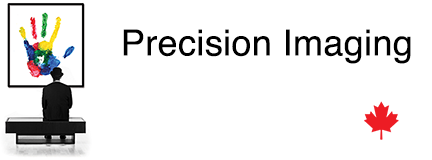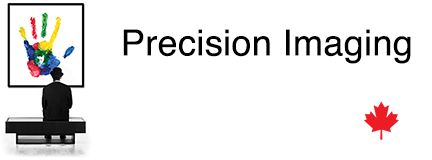Glossary of Photo Printing Terminology
-
Glossary of photo and art printing terms
-
-
Acrylic Face Mount
- An acrylic face mount is a treatment where the print is adhered, using an optically clear adhesive that is approximated 1/1000th of an inch thick, to the back of a sheet of 1/8 or 1/4 inch thick acrylic, to be viewed from the front of the acrylic -- through the acrylic. It is popular with photographers and artists as it creates an extremely deep and dramatic effect. A very tricky process that isn't offered for that reason by many imaging labs.
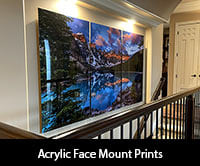
-
Aqueous Pigment Ink
- Aqueous Pigment Ink is a type of fine art and photography ink where encapsulated pigment particles are suspended in a water solution. In our opinion it is the best ink for fine art and photography printmaking and is the only type we use.
-
Archival Prints
- By definition archival simply means that it is created with materials that will last a long time. This is achieved by such things as papers that are made from cotton, have low acid content, have no optical brighteners. All of our fine art papers are considered archival. The other factor in an archival print is the type of ink used. There the consensus is that aqueous pigment ink is best.
-
Aspect Ratio
- Aspect ratio refers to the relationship of the dimensions of a rectangle. For instance, a 24x36 is a 2x3 aspect ratio: for every 2 units of measure along the short side, there are 3 on the long side. A square would be 1x1 aspect ratio. Aspect ratios can be any number x number. For our purposes, it usually comes into play when calculating the dimensions of an image when it gets blown-up large. For instance an 8x10, when you double the short side to 16, the long side goes to 20.
-
Canvas Varnish
- Canvas varnish is a coating that is applied over the canvas print to add protection including a UV blocker.
-
DPI or PPI
- DPI stands for dots per inch and refers to the number of dots per inch that make up a print. In digital printing, and for our purposes, DPI is interchangeable with PPI which stands for pixels per inch. The usual standard for printing is 300 dpi or ppi. We bump it up a bit from there to 360 because our printheads in our printers have 360 nozzles per inch. This isn't a concern for you in sending in your images. We will adjust the DPI before printing for the best possible outcome. Note: increasing DPI will not make a bad image look better. If it is noisy, grainy, or out of focus, and you increase the DPI, it will still look the same - it will just do a better job of printing it.
-
Dry-Mounting
- Dry-mounting is a process where a print, usually on paper, is permanently adhered to a substrate such as foam core or gator board. The process involves a thin sheet of mounting tissue between the piece and the substrate which is activated with a combination of heat and pressure in a dry-mounting vacuum-press. The process results in a print that is presented perfectly flat; sometimes it has the ability to "iron-out" wrinkles before the piece is framed.
-
Epoxy Resin Coating
- Epoxy Resin is a two part resin formula that is mixed 1:1 and sometimes 2:1. When used as a coating as we do, it goes on very clear, and cures very hard. We apply it to prints on canvas which results in a stunning effect on par with acrylic face mounting. It leaves a high gloss look that seems to give depth to the image; makes the dark ares deeper and the colours pop.
-
Floater Frame
- Floater Frames are a type of L-shaped frame, ours are made of wood, that a stretched canvas print is set in.
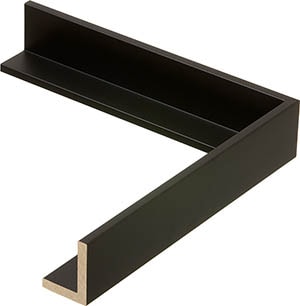 .
. 
-
Gallery-Wrap
- Gallery-Wraps are canvases that are stretched around stretcher bars (a wooden stretcher frame) and stapled on the back. There is either a solid colour, a mirror of the last inch or two of the image repeated on the side, or the image itself stretched over the side.
-
Giclee Printing
- Gliclee is a French word that roughly translates to "spurt" or "spray" and in printing refers to the method the ink is applied to the media: it is sprayed on. It is a process similar to how common inkjet printers lay down ink, except far more advanced in technology and materials used. The printing we do is considered Giclee Printing.
-
Mil
- A "mil" refers to a measurement of 1000th of an inch. For instance our canvas is 21mil thick, or a fine art paper might be 19mil and photo paper 10mil. In order to measure the thickness an instrument called a Micrometer is used. Besides measuring paper thickness, we also use one to measure the thickness of picture framing mats to cut the openings more accurately.
-
RGB
- RGB color is used for computer monitor color, and other display devices. It consists of three channels: red, green, and blue, to create colours on screens. The value of each of the three channels can be changed from 0 to 255. If all three channels are at 0, pure black is rendered. If all are 255, you will get pure white. By adjusting the three channels, any colour can be rendered. The printing equipment we use takes the RGB values to create the ink-mixtures needed to render the desired colour on the media being printed on. Some printing equipment requires that images be converted from RGB to CMYK (cyan, magenta, yellow, black) for printing, but because our equipment is meant for printing photography it is designed to read RGB.
-
Spectrophotometer
- A spectrophotometer is is a type of device that measures colour. For our purposes, we use them to calibrate our monitors to our printers for all the different media we print on. By matching the monitor to printer output, we have a better chance of accurately printing your colours. It also helps by compensating for different media, ie canvas, warm fine art paper, cool photo paper, so that colours look the same - or as close as possible - on all of them. This is achieved by printing test patches of solid colours, and then scanning those patches with a spectrophotometer that then creates a file called an ICC profile for that paper or canvas that tells the printer where to adjust colours to make them look as they were intended.
-
Stretcher Bar or Stretcher Frame
- Stretcher Bar refers to the wooden frame around which canvas prints are stretched. It is best to use a wood that is very low in acid like basswood.
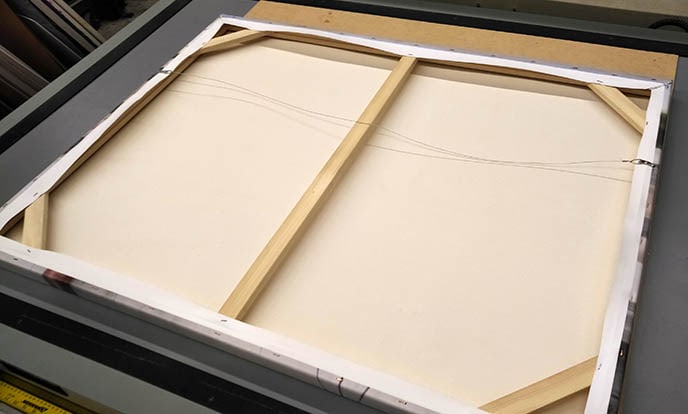
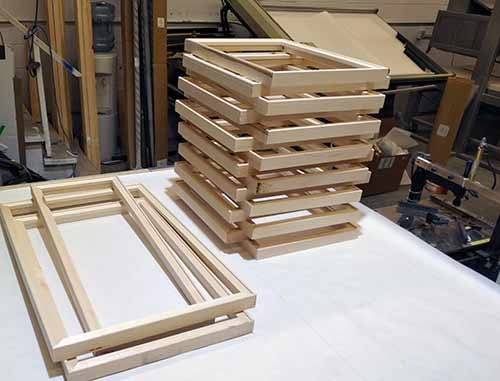

 .
. 


